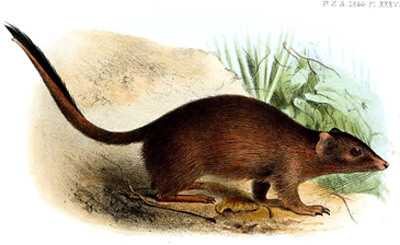
|
Search JoyZine with Google Site Search! |
Crest-tailed Mulgara Dasycercus cristicauda
There has been considerable taxonomic confusion and re-sorting of the mulgaras. For most of the last 30 years only one species, D. cristicauda, was recognized. More recently, based on some genetic and morphological attributes, two species were recognized, the mulgara, D. cristicauda, and ampurta, D. hillieri, with both occurring in the Northern Territory. However, Woolley (2005, 2006) re-considered the complex historical treatment of Dasycercus and re-assigned the species to the brush-tailed mulgara, D. blythi, and crest-tailed mulgara, D. cristicauda, both of which occur in the Northern Territory. Woolley distinguished these two species on the following characteristics: (i) appearance of black hairs on the distal half of the tail (a brush in D. blythi versus a dorsal crest in D. cristicauda), (ii) the number of upper pre-molar teeth (two in D. blythi versus three in D. cristicauda), and (iii) in females, the number of teats (6 in D. blythi versus 8 in D. cristicauda). Because most previous records did not distinguish among the two species of mulgara now recognized, there is ambiguity about the distribution of both species. The crest-tailed mulgara has been recorded in the southern Simpson Desert where the borders of the Northern Territory, Queensland and South Australia converge, and the Tirari and Strzelecki Deserts of South Australia. Historically, the species occurred on Sandringham Station in south-west Queensland, most of arid South Australia, including the Musgrave Ranges and the Lake Eyre Basin, and the Canning Stock Route and Great Sandy Desert in Western Australia. The species was last recorded in Sandringham Station in 1968 and subsequent surveys in 1971 and the 1990s were unsuccessful. The crest-tailed mulgara has higher densities in the central part of the Simpson Desert, where vegetation cover is low and surface water is scarce, compared with surrounding pastoral properties on the fringes of the Simpson Desert. The species occurs on sand dunes with a sparse cover of sandhill canegrass or areas around salt lakes with nitre bush. Complicated, extensive burrows are maintained with multiple entrances. The burrows are predominantly on the eastern side of dunes. Latrines are commonly located near the burrow entrance, with scats being up to 90mm long and 6mm wide. The crest-tailed mulgara has a lifespan in captivity of 5 years, but under natural conditions they are likely to live for only 2-3 years. Females probably mature in their first year but produce litters of up to eight. The species is a seasonal annual breeder, producing one litter of two to eight in early winter to early spring. The crest-tailed mulgara is an opportunistic or non-specialist carnivore, eating a range of invertebrates, lizards and small mammals. Birds and frogs are eaten less frequently. They have also been observed eating plant food (fruits and seeds). It forages along the dune crests and flanks, with forays down onto swales. The extent and reasons for decline of the crest-tailed mulgara are unclear. The introduced cat and fox may periodically exert excessive predation and decimate, and possibly extirpate, populations. Predation pressure is probably greatest a few years after heavy summer rainfall when predators have increased in numbers and rodent populations begin to crash. Additionally, grazing by the introduced rabbit, camel and livestock may cause declines at certain thresholds. Research has found that the abundance of the crest-tailed mulgara declines as that of the camel increases, although not so with the rabbit. Cattle damage dunes and vegetation, which may cause detrimental habitat change. The main threat to breeding success is lack of prey due to climatic variance, fire or disturbance. The species is more sedentary than many other desert insectivore/carnivores and therefore more sensitive to temporal fluctuation in food or habitat). The strict annual breeding cycle with only a single litter could make the species particularly sensitive to threatening processes such as fire or drought. |
